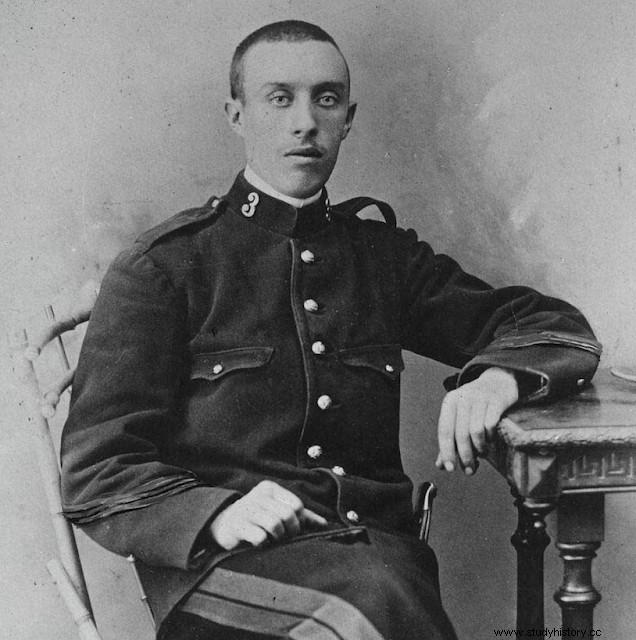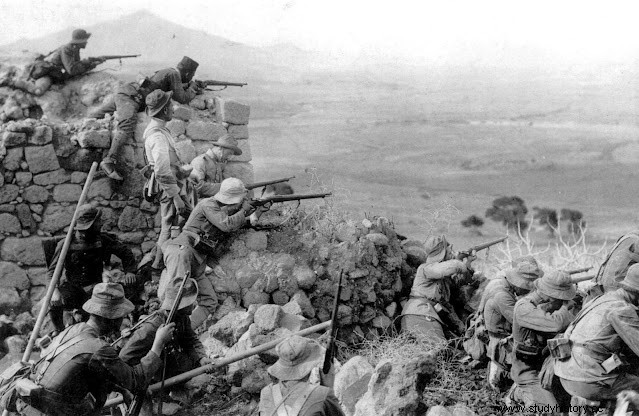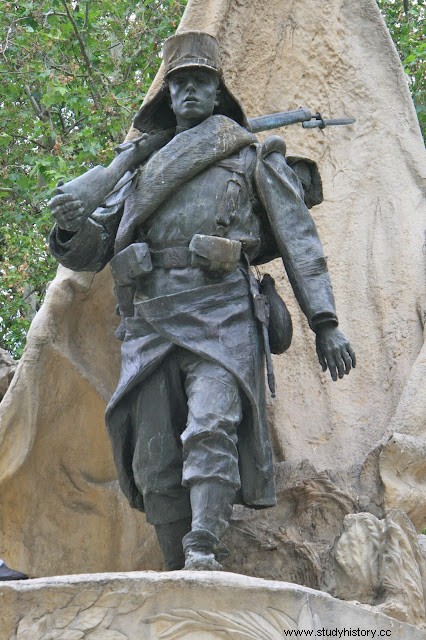"Pull, they are the Moors"
The young Asturian soldier did not hesitate to ask his companions to shoot at his own position, warning of the enemy's arrival even knowing that he was under fire crossed.
 Luis Noval Ferrao
Luis Noval FerraoHe was born into a humble family; His parents, Ramón Noval Suárez and Josefa Ferrao, lived in the city of Oviedo, and their son Luis was born on November 16, 1887. At the age of twenty-one, he entered the 1908 replacement, joining the Prince's Infantry Regiment n. º 3, where he was assigned, causing discharge in March 1909.
On April 11, 1909 he took the oath of allegiance to the flag, promoted by election to corporal in the month of September. On the 10th of that month he left Oviedo in the direction of Melilla.
On July 9, 1909, the Ministry of War was informed from Melilla that groups of Moors had suddenly attacked the Spanish workers who were working on the railways under construction, causing several deaths; troops from Melilla went out to carry out raids that cost a large number of casualties. In response to the offensive initiated from Melilla, the resistance of the Kabileños was organized, who were constantly reinforced by contingents from the interior. The military disaster of Barranco del Lobo occurred in the Spanish ranks, and the conquest of Gurugú was later considered a feat, although a large number of deaths and injuries resulted in it.
A generalized protest against the war in Morocco and against the sending of reservists. This movement opposed to warmongering, as the results were, which were very negative, was jointly formed by anarchists, socialists, republicans, workers, bourgeois, intellectuals. The Spanish tragedy and disaster was a fait accompli.
 Spanish soldiers defending a position in war in Morocco
Spanish soldiers defending a position in war in MoroccoAfter arriving in Melilla, Corporal Noval marched with his company to the fort of Cabrerizas Altas, later, on the 20th, he attended the battle of Taxdirt with his regiment, concurring under the orders of General Fernando Álvarez de Sotomayor, to the taking of the Zoco el Had of Beni-Sicar. Once the position was taken, the corresponding fortification and surveillance work was carried out; his column also formed the advance vanguard. The Rif harka, which had a considerable contingent, was divided into two parts, one located in Beni Bu Ifrur and the other in Beni Sicar. He had begun a pilgrimage, recruiting soldiers through the souks of the Kabyles to attack by surprise the Spanish position of Beni-Sicar.
 Battles of Hispania Official Store
Battles of Hispania Official StoreAt dawn on September 28 Corporal Luis Noval was commissioned to carrying out guard duty on the right flank of the camp. Around 2:30 in the morning, an enemy attack took place. Corporal Noval, seeing how complicated his situation was, began to withdraw and ordered his two guard comrades, Patiño and Fandiño, to follow him. Patiño does not hesitate and follows Noval, but Patiño decides to hide in a nearby trench. The Rif people open fire on the Spanish position behind the back of the two Spanish soldiers who are running for their lives towards the Spanish fortification. Under heavy crossfire they reach the door, but it is locked. Patiño managed to jump a wire fence and get to safety. Desperate Noval circled the fence that protected the enclosure trying to find an entrance.
When approaching the Spanish defensive position, the Moorish assailants shouted "Don't throw away that we are Spanish" . In the darkness of the night and after hearing these cries, the confused Spaniards stopped firing. The Spaniards had fallen into the trap of the Moors who were already almost at the gates of the fortification. Corporal Noval, upon witnessing what happened, stopped fearing for his life and wanted to save that of his companions. he shouted with all his might: "Pull, they are the Moors" alarming his companion that they continued firing at the enemy. Noval knew that this act of bravery was going to cost him his life since he was surrounded by hundreds of assailants. Not only was he not scared but he took the rifle from him and unloaded it against the mass of nearby enemies. But this hero would not live to tell about it...
After a night of rifle, bayonet and cannon, the Spanish finally managed to make the attacking army flee, which, according to official data, numbered about 1,500 men.
At dawn they found Corporal Noval's body with his regulation weapons, along with two enemy soldiers. Soldiers Ortiz and Rico picked up Noval's lifeless body, examining it by doctor Gaspar Araujo y Lucas, who found three mortal wounds, made by Mauser shots. For this event of singular bravery, and according to what his companions testified, he was posthumously awarded the 2nd Class Laureate Cross of San Fernando, with an annual pension of 400 pesetas for his parents.
 Sculpture in honor of Luis Noval Ferrao
Sculpture in honor of Luis Noval FerraoThe euphoria of popular heroism in the figure of Corporal Noval is translated with several monuments that were erected in different Spanish cities.
Corporal Luis Noval was initially buried in a mass grave, along with a sergeant and four soldiers of the Prince's Regiment, later the remains were exhumed on June 21, 1915, deposited in the pantheon of the victims of the campaign of the Rif, in Melilla. In 1916 they were definitively taken to Oviedo. Honor and Glory to this great Spanish hero.
